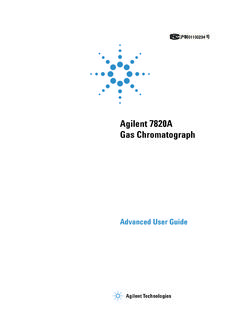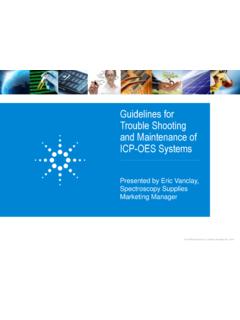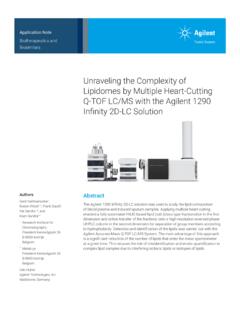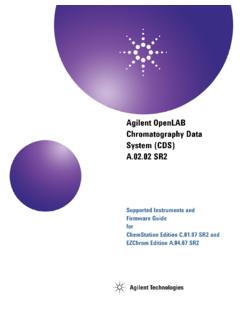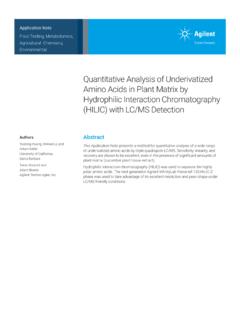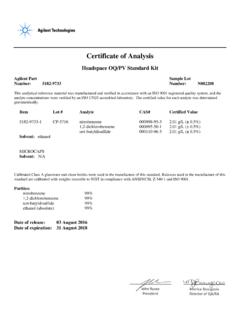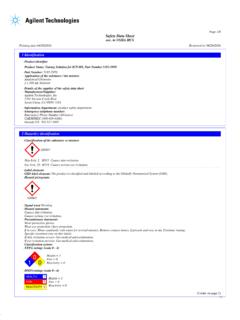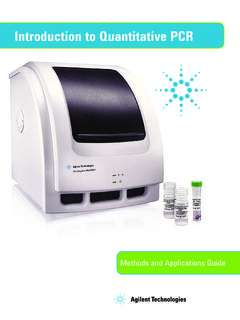Transcription of Leak Testing Steam Turbine Condensers - Agilent
1 Leak Testing Steam Turbine Condensers Application Note Introduction Power generation turbines, regardless of the type of fuel used, are driven by Steam generated in a boiler. The boiler heats water and converts it to Steam , spinning the Turbine and in turn, driving the generator that produces electrical power. After exiting the Turbine , the Steam is routed through a condenser, cooling the Steam back to water, which is then returned to the boiler to start the cycle again. The efficiency of this process is dictated by the pressure gradient across the Turbine and condensing system. Leaks in the system degrade the pressure differential and can easily result in power loss in excess of one megawatt per Turbine . However finding leaks in power plant circuits presents a challenging set of problems. Agilent Technologies, Vacuum Products Division, (formerly Varian Vacuum Technologies) has developed a leak test solution specifically designed for the demanding conditions found in power generation Condensers .
2 Steam Turbine Operation The most widely accepted method to identify air in-leak- age is the use of helium as a tracer gas and a mass The high pressure region of a Turbine is working at pres- spectrometer to detect helium. Various other methods sures as high as 165 bar, while the low pressure region have been used with limited success including ultrasonic operates at a pressure of to bar. Turbine back leak detectors . However, the latter do not work effectively pressure is a key parameter in Steam to power efficiency. in a noisy plant environment and have limited sensitivity. The typical design back pressure for a system is around bar. If this vacuum level deteriorates, due to air Condenser Leak Testing Using Helium in-leakage, leaky valves, or cooling tower problems, A helium leak detector is comprised of a high vacuum the efficiency of the entire system can decline rapidly.
3 Pump and backing pump, which provides the correct If even small amounts of non-condensable gas (air) are vacuum conditions for a small mass spectrometer. allowed to accumulate, they will inhibit heat transfer In a mass spectrometer, gasses are ionized and acceler- in the condenser and adversely affect performance. ated through a magnetic field which isolates gas mole- Large amounts can virtually block the condensation cules by mass. This separation allows extremely small process, which of course will cause a substantial rise in concentrations of helium to be detected, thus making back pressure. To prevent excessive accumulation, most it ideal for condenser leak Testing . Helium is sprayed power plants use Steam jet air ejectors and/or liquid ring around the vacuum portions of the condenser (Figure 1), vacuum pumps to remove the non-condensable gases.
4 While a mass spectrometer detects low concentrations When these methods cannot keep pace with the rate of of the gas at the outlet of the extractor or at other sites air in-leakage then the leaks must be found and repaired. within the vacuum region of the condenser. Steam Distribution Manifold Steam Turbine Air Cooled Condenser Air Injector Return to Boiler Liquid Ring Pump Condensate Tank Figure 1: Typical Air Cooled Condenser 2. In general, helium tracer gas Testing works very well condensing water vapor that would otherwise enter the because leaks can be sealed as soon as identified, auxiliary pump and the leak detector . This solution adds and subsequent Testing can be performed immediately significant cost and complexity to the leak test process. to confirm that the leaks are sealed. The use of helium In some cases, a permeable membrane has been used is advantageous as the gas is non-toxic, non-flammable in the tube connecting the leak detector to the con- non-reactive with other chemicals and very quickly dif- denser piping.
5 While this can keep water vapor out fuses though small leaks. The helium method allows of the leak detector , it also severely limits the leak test a maintenance engineer the flexibility to perform leak sensitivity and makes the leak test process questionable. tests while the plant is operating, without the need This is because the vacuum pressure in the condenser to isolate the section under test. piping, at bar, is sufficiently high to insure laminar Difficulties in Condenser Leak Testing viscous flow conditions. This means even though there is slight vacuum, there is also a very high density of gas While from a detection standpoint finding the leak is very molecules in the pipe and the mean free path for helium easy, the potential to damage the mass spectrometer is is only about 2 millimeters ( inches).
6 Any given heli- great. This is due to the environmental conditions inside um molecule can only move laterally 2 mm before it col- the condenser. The gas being sampled is very hot, is lides with other gas molecules. Helium flowing within almost entirely water vapor, and can be corrosive. Any of the gas stream in the pipe being tested is therefore these conditions can potentially damage the leak detec- swept along in the flow and cannot migrate laterally tor, yet the gas must be sampled in order to find the leak. to an outlet in the side of the pipe where the leak The helium leak detector normally operates at vacuum detector is connected. levels lower than the condenser, so a special test probe In simple terms, even though a leak is present, and even (commonly called a sniffer probe) is used that permits with helium flowing down the pipe, the helium frequent- detection at atmospheric level, which could be at the ly will not reach the test connection, and the leak detec- exhaust of the pumping system used to create the vacu- tor will not recognize the leak.
7 This condition is por- um conditions in the condenser. However, use of a con- trayed in the series of graphics in Figure 2, next page. ventional sniffer probe would be a serious problem, since These pictures will show: A The behavior of the flow water vapor in the exhaust would be pumped directly into through a pipe, B The concentration of helium within the leak detector resulting in breakdown of the pump the flow, C Sampling with a membrane mounted on the lubricating oil and other damage to the unit. The sniffer side wall of the pipe, and D Using an insertable mem- probe performance would be quickly degraded by water brane probe to sample in the center of the pipe. vapor condensing and blocking the orifice and probe line. Another aspect to consider is the logistics of leak test- If a water/ Steam ejector pump is used for the con- ing in a large, multi-story power plant where the leaks denser evacuation, connection to a conventional sniffer are usually a long distance from the mass spectrometer.
8 Probe is not possible. In this case, an auxiliary vacuum Since most helium leak detectors are not equipped pump is commonly used just before the ejector pump with remote readout and control capability, leak detec- with the sniffer probe inserted into the exhaust of this tion is typically a 2- or 3-person operation where contact auxiliary pump. This arrangement has the same short- between one operator spraying helium and another comings because the sample is still mostly water vapor. observing the leak detector display is conducted literally However, the Steam can be conditioned with the use by shouting or by two-way radio. of a desiccant cartridge or a cold trap, thereby 3. A the behavior of the flow through a pipe B the concentration of helium within the flow Area of significant ga gas flow near central Flow profile Pipe in test ax axis of pipe Zero flow at wall Helium atoms with a mean Maximum flow free path of E-4 centimeters rs at central axis are captured in the primaryy viscous, laminar gas flow by successive collisions with more massive and more La Large molecules su such as water vapor, numerous gas molecules nitrogen.
9 Oxygen C sampling with a membrane mounted on the D using an insertable membrane probe to sample side wall of the pipe in the center of the pipe Flow profile Pipe in test Pipe in test Zero flow at wall Maximum flow Maximum flow at central axis at central axis Minimal gas flow in lateral Probe installed directly in test port with limited helium primary gas flow for high sensitivity and reliable migration to leak detector leak test response. Can Connecting hose be adjusted for various Leakk Membrane trapped of convenient pipe diameters. Detector tor between flanges diameter and length leak detector Figure 2: Gas flow characteristics and the effect on sampling Summary Successful leak Testing of power plant systems requires overcoming three significant problems: 1. Heated water vapor in the piping to be tested 2.
10 Detection of tracer gas helium in viscous laminar flow conditions 3. Communication with the leak detector over long distances within the power plant 4. The Agilent Solution To address the challenges of leak Testing in the harsh environments of the power generation industry, Agilent has developed a specialized sampling probe and leak detector configuration tailored to these requirements. The Agilent VS Harsh Environment (HE) Probe (Figure 3). is designed to withstand the wet environment and high temperatures inside condenser piping without dryers, chillers, a secondary vacuum pump, or throttling valves. The probe can be: 1. Positioned in the exhaust of a liquid ring pump on the condenser system, 2. Flange-mounted directly into the piping of the system under test (as shown to the right). The probe is connected to the flange via an adjustable compression fitting so the probe tip can be positioned in the center of the pipe.
